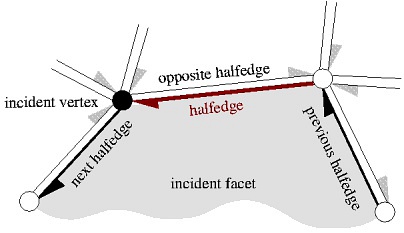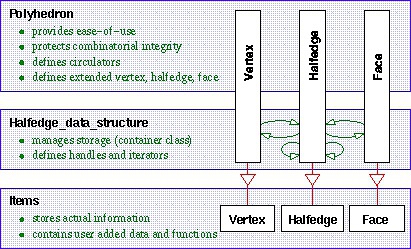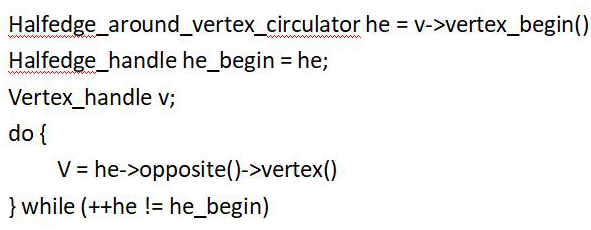作者:Lutz Kettner Introduced in 版本引入: CGAL 1.0 BibTeX 文献排版: cgal:k-hds-17b License 版本许可: LGPL
半边结构是一个以边为中心的数据结构,这个结构可以保持顶点、边和面的关联关系,例如对于平面图、多面体或其他嵌入在任意维度中的定向、二维表面。
- 每一条边被分解为相反反向的两个半边
- 每个半边中保存有一个关联面和一个关联顶点
- 对于每一个边和每一个顶点,保存有一个关联半边
- 半边数据结构变化的减少可以忽略一些信息,例如半边指向面或存储在所有的面中
介绍
半边数据结构,简写为HalfedgeDS,模板参数里写为HDS。是一个以边为中心的数据结构。
平面图,多面体或者其他二维定向表面均可以使用半边数据结构。每个边都分成两个方向相反的半边。每条半边都存储它的一个入射面和一个入射点。
软件设计
三层式的软件设计结构

Items层
items存储了实实在在的点边面的信息,包括成员变量,以及访问它们的成员函数
halfedges被要求提供指向下一个halfedge和对面halfedge的引用。有时候也可以让halfedge提供指向前一个halfedge的引用。
更进一步的,items类还能通过继承与派生扩展机制,可以携带任意属性,任意成员函数
点,半边和面都被当做items类的局部类型传递给半边数据结构和polyhedron。最基本的对点线面的应用CGAL已经提供了,用户可以将其作为基类使用
HalfedgeDS层
HalfedgeDS内部双向链表或者vector可以实现对底层item的存储。HalfedgeDS有两种模型:HalfedgeDS_list和HalfedgeDS_vector。
HalfedgeDS定义了items的handle和iterator。
为了保持这两个模型的接口简洁,有些通用的功能就留给了其他的辅助类,比如HalfedgeDS_decorator, HalfedgeDS_const_decorator, HalfedgeDS_items_decorator
- 在上图中没有显示,但它们应该画在HalfedgeDS的旁边,因为它们扩展了接口并且没有隐藏这些接口
- 这些辅助类包含的一些操作能辅助更高的layer比如Polyhedron层实现一些操作
- 此外,辅助类包含适应性功能。比如说,如果halfedges没有HalfedgeDSHalfedge::prev()成员函数,辅助类中的HalfedgeDS_items_decorator::find_prev()成员函数就会沿着面的正向查找前继的halfedge。但如果有HalfedgeDSHalfedge::prev()这个成员函数,HalfedgeDS_items_decorator::find_prev()就只要调用一下HalfedgeDSHalfedge::prev()就可以了
Polyhedron_3
最高层用Polyhedron_3来举例子
Polyhedron_3对下层接口进行了很好的封装
- 比如将face重新命名成facet
- 比如handles不能直接被用户访问
- 比如提供了circulators使得用户能够访问一个vertex或facet周围环绕的edges的环形序列
这一切都是Polyhedron_3通过从Items中派生出新的vertices, halfedges 和 facets得到的
例子
半边结构的访问
默认的半边数据结构
接下来的例子用了默认的半边数据结构和decorator类。
- 默认的半边数据结构使用了链表式的构造。
- items之间的关联关系和vertices的类型都在这里定义。
- trivial traits这个类提供了点的类型
这个程序创建了一个环(loop),环里面包含两条半边,一个点和两个面,程序还检测了这个图形的有效性。
#include <CGAL/HalfedgeDS_default.h>#include <CGAL/HalfedgeDS_decorator.h>struct Traits { typedef int Point_2; };typedef CGAL::HalfedgeDS_default<Traits> HDS;typedef CGAL::HalfedgeDS_decorator<HDS> Decorator;int main() {HDS hds;Decorator decorator(hds);decorator.create_loop();CGAL_assertion( decorator.is_valid());return 0;}
一个最小的半边数据结构
接下来这个程序用最小的items类 HalfedgeDS_min_items,搭配链表型的半边数据结构定义了一个最小的半边数据结构。
这个数据结构只包含半边(下一条边和对边的指针),没有存储点或者面的信息。这是个无向图。
#include <CGAL/HalfedgeDS_min_items.h>#include <CGAL/HalfedgeDS_default.h>#include <CGAL/HalfedgeDS_decorator.h>// no traits needed, argument can be arbitrary dummy.typedef CGAL::HalfedgeDS_default<int, CGAL::HalfedgeDS_min_items> HDS;typedef CGAL::HalfedgeDS_decorator<HDS> Decorator;int main() {HDS hds;Decorator decorator(hds);decorator.create_loop();CGAL_assertion( decorator.is_valid());return 0;}
将默认的链表型的HalfedgeDS改为vector型
默认的半边数据结构内用链表型的构造,继承自最复杂的基类。我们现在将其转化为vector型的构造。
- trivial traits类决定了点的数据类型
- 要注意,vector的容量要事先就保留好,通过例子里的构造函数或者reserve()成员函数都能达到这种效果
- 也可以事后再调用reserve()函数去修改容量,但是要保证内存中的空间是连续的
#include <CGAL/HalfedgeDS_items_2.h>#include <CGAL/HalfedgeDS_vector.h>#include <CGAL/HalfedgeDS_decorator.h>struct Traits { typedef int Point_2; };typedef CGAL::HalfedgeDS_vector< Traits, CGAL::HalfedgeDS_items_2> HDS;typedef CGAL::HalfedgeDS_decorator<HDS> Decorator;int main() {HDS hds(1,2,2);Decorator decorator(hds);decorator.create_loop();CGAL_assertion( decorator.is_valid());return 0;}
向facet添加颜色
这个例子重新使用了face的基类,加入了一个颜色变量。
#include <CGAL/HalfedgeDS_items_2.h>#include <CGAL/HalfedgeDS_default.h>#include <CGAL/IO/Color.h>// A face type with a color member variable.template <class Refs>struct My_face : public CGAL::HalfedgeDS_face_base<Refs> {CGAL::Color color;My_face() {}My_face( CGAL::Color c) : color(c) {}};// An items type using my face.struct My_items : public CGAL::HalfedgeDS_items_2 {template <class Refs, class Traits>struct Face_wrapper {typedef My_face<Refs> Face;};};struct My_traits { // arbitrary point type, not used here.typedef int Point_2;};typedef CGAL::HalfedgeDS_default<My_traits, My_items> HDS;typedef HDS::Face Face;typedef HDS::Face_handle Face_handle;int main() {HDS hds;Face_handle f = hds.faces_push_back( Face( CGAL::RED));f->color = CGAL::BLUE;CGAL_assertion( f->color == CGAL::BLUE);return 0;}
定义一个更加紧凑的半边结构
Iterator
用默认的半边数据结构创建了两个边以后。可以用半边iterator来计算halfedges了。
#include <CGAL/HalfedgeDS_default.h>
#include <CGAL/HalfedgeDS_decorator.h>
struct Traits { typedef int Point_2; };
typedef CGAL::HalfedgeDS_default<Traits> HDS;
typedef CGAL::HalfedgeDS_decorator<HDS> Decorator;
typedef HDS::Halfedge_iterator Iterator;
int main() {
HDS hds;
Decorator decorator(hds);
decorator.create_loop();
decorator.create_segment();
CGAL_assertion( decorator.is_valid());
int n = 0;
for ( Iterator i = hds.halfedges_begin(); i != hds.halfedges_end(); ++i )
++n;
CGAL_assertion( n == 4); // == 2 edges
return 0;
}
用适配器来建立一个edge iterator
用默认的半边数据结构创建了3跳变。适配器N_step_adaptor声明了edge iterator。
#include <CGAL/HalfedgeDS_default.h>
#include <CGAL/HalfedgeDS_decorator.h>
#include <CGAL/N_step_adaptor.h>
struct Traits { typedef int Point_2; };
typedef CGAL::HalfedgeDS_default<Traits> HDS;
typedef CGAL::HalfedgeDS_decorator<HDS> Decorator;
typedef HDS::Halfedge_iterator Halfedge_iterator;
typedef CGAL::N_step_adaptor< Halfedge_iterator, 2> Iterator;
int main() {
HDS hds;
Decorator decorator(hds);
decorator.create_loop();
decorator.create_segment();
CGAL_assertion( decorator.is_valid());
int n = 0;
for ( Iterator e = hds.halfedges_begin(); e != hds.halfedges_end(); ++e)
++n;
CGAL_assertion( n == 2); // == 2 edges
return 0;
}



